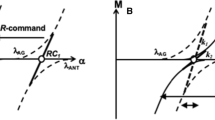Abstract
Recently, a model for a pair of antogonistic muscles has been studied (Oğuztöreli and Stein, 1982). In the present paper we formulate and investigate the minimization of the costs associated with the time to complete the movement, the oscillation about the end-point, the energy costs to the muscles to complete the movement, the cost to the nervous system to supply the inputs, and the cost of reliability in the face of perturbing forces. To solve these optimization problems the maximum principle of Pontryagin is employed. In all of these optimization problems, except the energy optimal problem, the optimal controls (active states or nervous inputs) are of the bang-bang type.
Similar content being viewed by others
References
Boltyanskii, V.G.: Mathematical methods of optimal control. New York: Holt, Rinehart, and Winston 1971
Hallett, M., Shahani, B.T., Young, R.R.: EMG analysis of sterotyped voluntary movements in man. J. Neurol. Neurosurg. Psychiat. 38, 1154–1162 (1975)
Hatze, H.: Optimal processes of neuro-muskulo-skeletal control systems. In: Mathematical modelling in biomathematics. Lecture Notes in Biomathematics, Vol. 33. Berlin, Heidelberg, New York: Springer 1980, pp. 19–39
Hill A.V.: The heat of shortening and dynamic constants of muscle. Proc. R. Soc. (London) B 126, 136–195 (1938)
Hogan, N.: Adaptive control of natural joint stiffness by antagonist muscles (in press)
Huxley, A.F.: Review lecture: muscular contraction. J. Physiol. 243, 1–43 (1974)
Kornhuber, H.H.: Motor functions of cerebellum and basal ganglia: the cerebello-cortical saccadic (ballistic) clock, the cerebellonuclear hold regulator, and the basal ganglia ramp (voluntary speed smooth movement) generator. Kybernetik 8, 157–162 (1971)
Lee, E.B., Markus, L.: Foundations of optimal control theory. New York, London Sydney: Wiley 1967
Macki, J., Strauss, A.: Introduction to optimal control theory. Berlin, Heidelberg, New York: Springer 1982
Margaria, R.: Biomechanics and energetics of muscular exercise. Oxford: Clarendon Press 1976
Mohler, R.R.: Bilinear control processes. New York, London: Academic Press 1973
Mommaerts, W.F.H.M.: Muscular contraction. Physiol. Rev. 49, 427–508 (1969)
Oğuztöreli, M.N., Stein, R.B.: Analysis of a model for antagonistic muscles. Biol. Cybern. 45, 177–186 (1982)
Pontryagin, L.S., Boltyanskii, V.G., Gamkrelidze, R.V., Mishchenko, E.F.: The mathematical theory of optimal processes. Transl. from Russian Trirogoff, K.N., Neustadt, L.W. (eds.). New York: Interscience 1962
Author information
Authors and Affiliations
Additional information
This work was partly supported by the Natural Sciences and Engineering Research Council of Canada Grant NSERC-A4345 and by the Medical Research Council of Canada Grant MRC-MA-3307 through the University of Alberta
Rights and permissions
About this article
Cite this article
Oğuztöreli, M.N., Stein, R.B. Optimal control of antagonistic muscles. Biol. Cybern. 48, 91–99 (1983). https://doi.org/10.1007/BF00344392
Received:
Issue Date:
DOI: https://doi.org/10.1007/BF00344392




